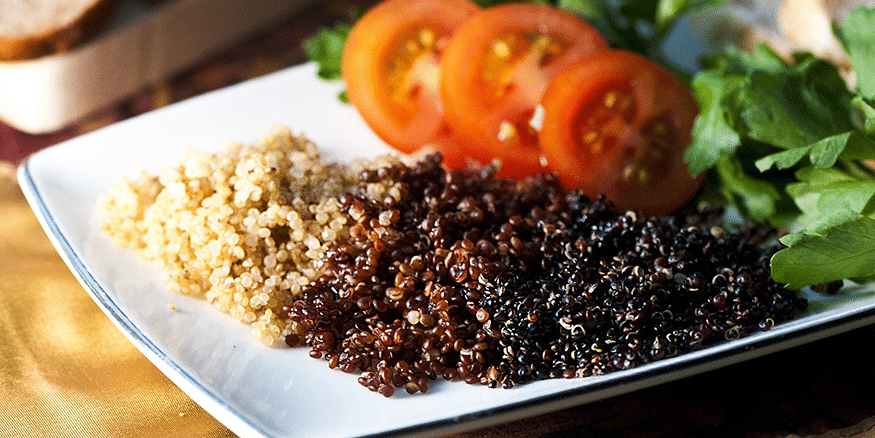
Get Keen for Quinoa!
Quinoa, pronounced keen-wah, is an annual herb native to the Andean region of South America that is quickly gaining popularity in North America. The stalks of the plant grow three to six feet high, with clusters of seeds near the top. Both the leaves and the seeds of the plant are edible, but the seeds are more widely available for purchase in Canada. A bitter resin called saponin forms a coating on the seeds, providing the plant with protection from birds and insects. A thorough rinsing or soaking of the seeds before cooking removes the resin, and some stores carry processed seeds that already have the resin removed. The main producers of quinoa include Columbia, Ecuador, Peru, Bolivia, Chile, and Argentina.
While the most popular type of quinoa, Chenopodium quinoa, is a transparent yellow colour, other varieties come in orange, red, purple, and black. Cooked quinoa has a fluffy, slightly crunchy texture with a subtle nutty flavour. Quinoa seeds can enhance many dishes: you can add some seeds to salads such as tabouli, substitute quinoa in recipes requiring rice or couscous, or top some with fruits and nuts as an alternative to porridge. Quinoa flour works well as a wheat flour substitute in muffins or cookies.
Nutritional Value
Often referred to as a superfood, quinoa has an excellent nutritional profile. In general, proteins derived from plant sources tend to be low in essential amino acids, but not quinoa! It is a complete protein, meaning it provides an adequate proportion of all of the essential amino acids required by humans, making it a favourite food of many vegetarians. It is high in fibre, providing 2.6g in just half a cup of cooked quinoa, and it is a very good source of several minerals, including iron, magnesium, phosphorus, and zinc.
Gluten-Free
Gluten is a type of protein found in grains such as wheat, rye, barley, and triticale, but its presence is not limited to grain products. You can also find gluten in many other products, because manufacturers add it during processing to help bind and stabilize food products. Individuals who have celiac disease have an adverse gut reaction to gluten; ingestion of even the tiniest amount (a single molecule) causes damage to the absorptive surface of the small intestine. The only treatment for celiac disease is a strict gluten-free diet. Quinoa in its various forms (seeds, flakes, flour) does not contain gluten, so it safe for people with celiac disease or for individuals who have a gluten intolerance or allergy.
Considering Quinoa?
Quinoa has long been available in natural food stores, but more mainstream grocery stores are also starting to stock it. It is generally available for sale in pre-packaged containers or in bulk bins. Some things to keep in mind when purchasing quinoa:
- When buying in bulk, make sure the containers are covered and that the store has good product turnover to ensure freshness.
- Check that the bulk bin or the package is free of moisture.
- When deciding how much to buy or to prepare, take into account that quinoa expands considerably during cooking.
- Store in an airtight container.
Breakfast Quinoa Recipe
With its high nutrient content and versatility, quinoa is a great alternative to other hot or cold breakfast cereals. Try this quick and easy recipe to energize your body in the mornings. Serves 2-4.
Ingredients:
- 1 cup quinoa seeds, preferably a pale colour (dry)
- 2 cups water
- 3 Tbs almond butter or sliced raw almonds
- 2 Tbs honey
- 1 cup fresh berries of your choice
- Cinnamon, to taste
- Salt, to taste
- Milk or milk alternative, to taste
Method:
- Rinse quinoa under running tap water, thoroughly straining out the liquid.
- Add quinoa, 2 cups of water, and a dash of salt to a small pot, and bring to a boil. Once it has been boiling for a few seconds, reduce the heat to low and cover with a tight-fitting lid. Allow it to cook for about 15 minutes, until the water is absorbed, then remove the lid and stir it. Mix in the honey, almond butter, and cinnamon.
- Serve quinoa with fresh berries and milk or milk alternative, as desired.
Note: When cooking the quinoa, you can replace part or all of the water with milk to make it creamier, and if you prefer a cold cereal in the morning, you can cook the quinoa the night before and refrigerate.
